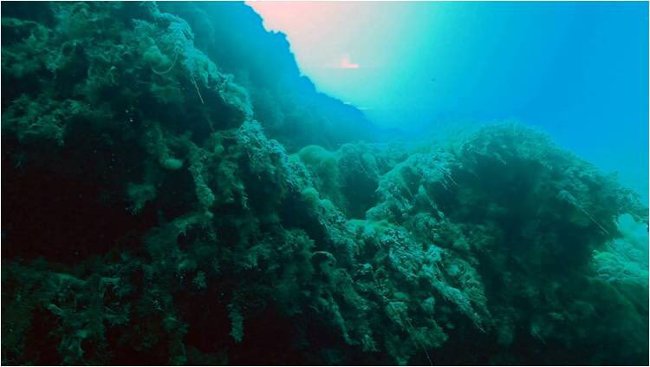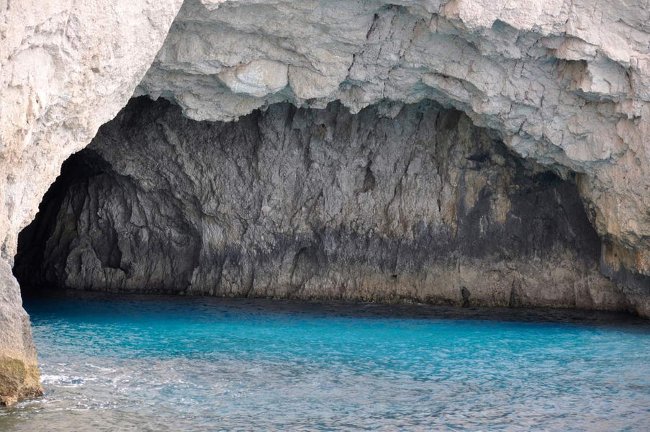Explore the world's deepest green hole in the South China Sea
The new exploration of a mysterious green hole in the South China Sea has shown that it is the deepest green hole in the world. According to Xinhua, Longdong or Dragon's pit is 300.89 m deep and deeper than the blue hole Dean in the Bahamas - once held the previous record (Dean's blue hole is about 202 m deep). Ancient legends say that the Dragon hole was mentioned in the " Journey to the West " Ming Dynasty novel - a supernatural monkey given a wand by a dragon who ruled the kingdom deep under the sea.

Scientists in this field are still testing and confirming this, but Dr. Pete van Hengstum, a marine geologist at Texas A&M University, said: if measured in size, the Dragon hole deeper than the blue hole Dean. He conducted research in green holes and water funnels that flow through the Caribbean.
Water wonders
Dr Van Hengstum said: "Blue holes are funnels filled with water to create carbonate rocks like limestone." For a long time, the carbonate rock mass dissolved below the ground and created caves or holes.
" Finally, the dissolution process causes the cave to approach closer to the surface of the Earth and if the ceiling of the cave falls, it will form a blue hole or a water funnel ." Some green holes, like the Dragon hole, create a marine environment and other holes are inland.

Some mysteries are why blue holes are formed in this place and what factors affect their development. Lisa Park Boush, a geography scientist at the University of Connecticut, is a researcher of the sediments found in green holes, saying that the general chemical reaction between salt water and fresh water can produce weak and corrosive acids. limestone as well as other types of carbonates. As a result, sea level rise and fall can affect the time and place of green hole formation.
Boush also replied to Live Science: " There is a research team that learns about bacterial activity ." In some cases, bacteria can help dissolve the bedrock and build green holes. In addition to bacteria, other creatures also consider these beautiful natural wide holes to be their home.
Life in the green hole
Geography scientist Boush said: " It's great to directly see life in green holes ," and call the habitat in green holes a " mystery ".
According to Xinhua, scientists together with the Sansha Ship Research Institute on coral protection in China have used underwater robots and depth sensors to discover the mysterious world of the Dragon Hole. - is a special point in Yongle, a coral reef near Xisha islands in the East Sea. They found more than 20 marine creatures living on the top of the pit. On July 22, the researchers replied that: Under a depth of about 100 m, the seawater in the blue hole is nearly oxygen-free, so there is very little life.

She also notes that deep diving in the blue holes is extremely dangerous and that is " One of the reasons why it is so dangerous is because of the oxygen limit and even there is a lot of it. sulfuric water . "
Dr Van Hengstum said: " Well trained divers can participate in that visit ." In other cases, researchers park their boats right on the green hole and drop the device to measure depth, temperature, oxidation and other factors. Both Boush and van Hengstum studied the sediments at the bottom of the green holes. These sediments contain information about the past environment, climate change and sometimes fossils.
Van Hengstum also said that the Dragon hole in the South China Sea was formed in the same environment as the green holes in the Bahamas. More recently, many green holes are flooded by sea water in the Bahamas like water-digging funnels during the glacier period when the sea level is lower. But after the last ice age flooded, continental glaciers melted and sea levels around the world increased.
Boush said: "The Bahamas is on a large flat carbonate with places up to 610 m. Some of these carbonates are haunted by organisms such as corals - excreting calcium carbonate as a protective structure. But calcium Carbonates are also present in lime algae (algae with hard calcium carbonate skin layer) and even in fish feces ".
" Fish eat coral reefs, " Boush said. " For example: The grouper chews. When you dive with the compressed air, you will hear a 'click, click, click, click, click' and that's the sound of grouper eating coral. Yes, that's all even what happens is repeated. "
You should read it
- black hole, white hole, deep hole
- Discover the most bizarre black holes in the mysterious space universe
- Discover a monster black hole 100,000 times bigger than the Sun, the second largest in the Milky Way
- 10 interesting facts about black holes in the universe (Part 2)
- Meizu Zero, the first 'no-hole' smartphone in the world has been revealed
- Hole.io, the death-death game that eats the addictive world, invites download and experience
- This girl was the one who used the 'capture' algorithm to capture the first black hole in history
- This is a photograph of the first black hole of mankind, located in a galaxy 55 million light-years from Earth
May be interested
- black hole, white hole, deep hole
 a black hole is a concept that is no longer new to most astronomers and physicists. in this article i will try to write in a short and understandable way possible about the concepts: black holes, white holes and deep holes.
a black hole is a concept that is no longer new to most astronomers and physicists. in this article i will try to write in a short and understandable way possible about the concepts: black holes, white holes and deep holes. - The world's deepest sunken shipwrecks ever discovered
 the famous titanic sank in 1912 at a depth of about 3,810 meters, more than twice the depth of the grand canyon in the us and five times the height of the tallest building in the world, dubai's burj khalifa, but still far from the deepest wreck ever discovered.
the famous titanic sank in 1912 at a depth of about 3,810 meters, more than twice the depth of the grand canyon in the us and five times the height of the tallest building in the world, dubai's burj khalifa, but still far from the deepest wreck ever discovered. - Discover the most bizarre black holes in the mysterious space universe
 black holes exist in many different forms, from the oldest black hole that was born 770 million years after the big bang or the largest black hole has billions of times the mass of the sun. here is a list of the 10 most typical black holes in the universe that people have ever known.
black holes exist in many different forms, from the oldest black hole that was born 770 million years after the big bang or the largest black hole has billions of times the mass of the sun. here is a list of the 10 most typical black holes in the universe that people have ever known. - Close-up of the deepest living fish in the ocean ever recorded by camera
 this is the deepest living fish on the seabed ever recorded. university of western australia deep-sea scientist, professor alan jamieson, said that if this record is broken, it is likely that the depth will only increase by a few meters.
this is the deepest living fish on the seabed ever recorded. university of western australia deep-sea scientist, professor alan jamieson, said that if this record is broken, it is likely that the depth will only increase by a few meters. - China claims to be the first country to bring the probe to the Moon's shadow in 2018
 china solemnly announced that it will accelerate the development of aerospace technology as well as realize the plan to become the first country in the world to safely land a probe on the far side. (the dark) of the moon in 2018 here.
china solemnly announced that it will accelerate the development of aerospace technology as well as realize the plan to become the first country in the world to safely land a probe on the far side. (the dark) of the moon in 2018 here. - Instructions for entering the latest Ni no Kuni: Cross Worlds codes and codes
 ni no kuni: cross worlds is the latest installment in level-5's fantasy rpg series. participating in ni no kuni: cross worlds, players can choose 1 of 5 character classes, including destroyer, engineer, rogue, swordsman and witch.
ni no kuni: cross worlds is the latest installment in level-5's fantasy rpg series. participating in ni no kuni: cross worlds, players can choose 1 of 5 character classes, including destroyer, engineer, rogue, swordsman and witch. - Discover a monster black hole 100,000 times bigger than the Sun, the second largest in the Milky Way
 japanese astronomers discovered a supermassive black hole hidden in a cloud of suspended gas near the center of the milky way with a diameter of up to 1400 billion km and a mass of 100,000 times the sun.
japanese astronomers discovered a supermassive black hole hidden in a cloud of suspended gas near the center of the milky way with a diameter of up to 1400 billion km and a mass of 100,000 times the sun. - Beautiful Green Tree Background, download Beautiful Green Tree Background here
 beautiful green tree background. trees are the lungs of the earth and are one of the symbols of the green planet we live on. if you are interested in green tree images and want to find beautiful green background, please take the time to follow this article!
beautiful green tree background. trees are the lungs of the earth and are one of the symbols of the green planet we live on. if you are interested in green tree images and want to find beautiful green background, please take the time to follow this article! - 10 interesting facts about black holes in the universe (Part 2)
 in the first part, we learned how a black hole grows, the number of supermassive black holes in the universe ... in this next section, we will learn some other interesting mysteries. about cosmic black holes.
in the first part, we learned how a black hole grows, the number of supermassive black holes in the universe ... in this next section, we will learn some other interesting mysteries. about cosmic black holes. - Ni no Kuni: Cross Worlds - How to turn off auto-battle and auto-play
 ni no kuni: cross worlds is a comprehensive multiplayer role-playing game from developer level-5, with cutscenes made by studio ghibli, the renowned animation studio that has made iconic films such as my neighbor totoro and spirited away.
ni no kuni: cross worlds is a comprehensive multiplayer role-playing game from developer level-5, with cutscenes made by studio ghibli, the renowned animation studio that has made iconic films such as my neighbor totoro and spirited away.










 Surprise with the facts about the ocean
Surprise with the facts about the ocean Will disaster happen when the leaves in Chernobyl area do not decompose?
Will disaster happen when the leaves in Chernobyl area do not decompose? Hate to make a strange snake lizard-like creature
Hate to make a strange snake lizard-like creature What ancient monsters can kill Megalodon super shark?
What ancient monsters can kill Megalodon super shark? The slug race - the strange slow-motion race in human history
The slug race - the strange slow-motion race in human history Jade snake snake - Beauty queen snake in Vietnam
Jade snake snake - Beauty queen snake in Vietnam